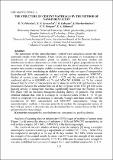Поиск по всему репозиторию:
The Structure of Cement Materials by the Method of Nanoindentation

Открыть/скачать файлы документа
Автор
Дата издания
2023Издательство
БрГТУУДК
666.972:539.421.2Библиографическое описание
The Structure of Cement Materials by the Method of Nanoindentation / E. N. Polonina [и др.] // Теория и практика исследований, проектирования и САПР в строительстве = Research, design & cad in construction: theory and practice : сборник статей VI Международной научно-технической конференции, Брест, 23 ноября 2023 года / Министерство образования Республики Беларусь, Брестский государственный технический университет, Строительный факультет, ОЛ НИЦИС БрГТУ, ООО «Лира САПР», ООО «ПСС-SOFiSTiK», ООО НПФ «СКАД СОФТ», ОДО НПП «Брест-КАД», Филиал РУП «Институт БелНИИС» – Научно-технический центр ; редкол.: Н. Н. Шалобыта [и др.]. – Брест : БрГТУ, 2023. – С. 105–113. – Библиогр.: с. 113 (16 назв.).Аннотация
The parameters of the nanoindentation method were selected to ensure the final consistent results were obtained. These results are presented by histograms of the distribution of nanoindentation points by elasticity and hardness moduli and distributions by these characteristics in the horizontal XY plane perpendicular to the movement of the nanoindenter. It was revealed that the elastic modulus increases in samples that contain a complex additive containing nano-sized particles. The effect is also observed when introducing an additive containing only one type of nanoparticles (hydrothermal SiO 2 nanoparticles or multiwalled carbon nanotubes MWCNTs. Studies of cement stone samples at W/C = 0,21 and the content of SiO2 in the combined additive is 0,000006 wt. % and MWCNT 0,00004 wt. % for cement showed that the effect of nanoparticles on the structure of the CSH gel becomes more pronounced, because the volume fraction of the LD phase of the CSH gel with a low packing density of nanograins becomes significantly lower than the fraction of the HD phase with an increased hexagonal packing density of granules. The results obtained indicate that there is a change in the nanostructure of the C −S −H gel, which is compared with an increase in strength, Young's and shear moduli with the introduction of SiO 2 nanoparticles and MWCNT nanoparticles. Using the nanoindentation method, it becomes possible to explain the nanogranular nature of the CSH gel, which is characteristic and determined by the contact forces of the CSH gel particles for these phases.
URI документа
https://rep.bstu.by/handle/data/42531Документ расположен в коллекции

Это произведение доступно по лицензии Creative Commons «Attribution-NonCommercial» («Атрибуция-Некоммерчески») 4.0 Всемирная.